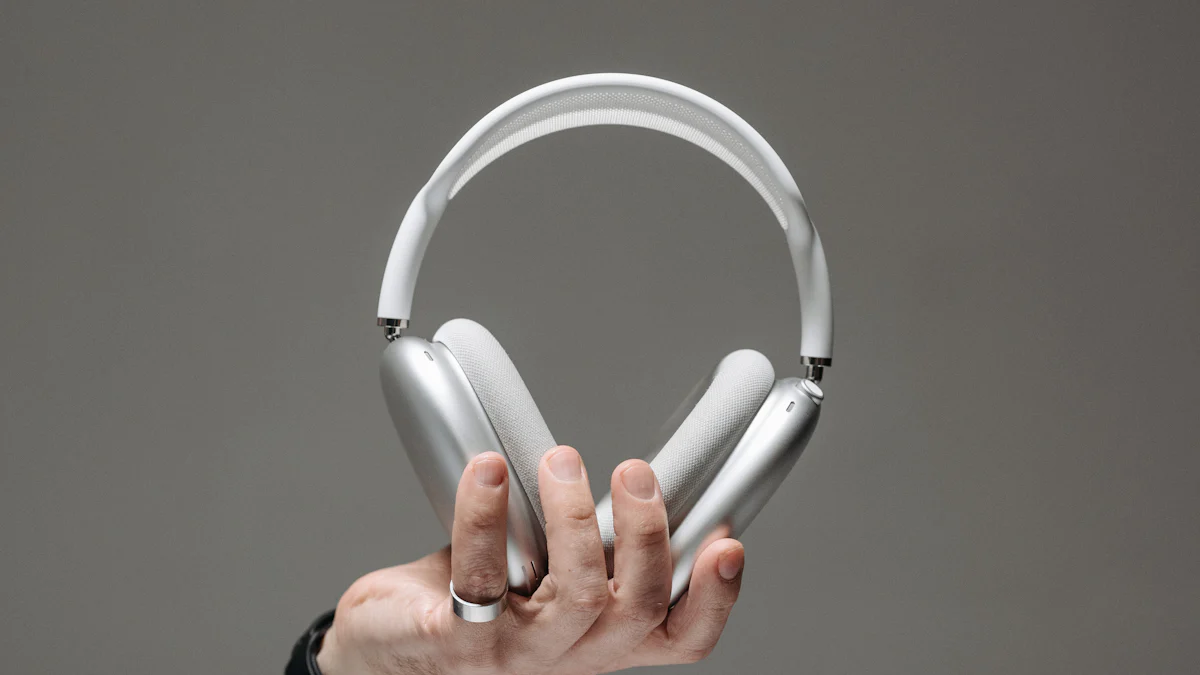Understanding Noise-Cancelling Headsets for Clearer Calls

Noise-cancelling technology transforms your calling experience by eliminating unwanted sounds. It uses tiny microphones to detect ambient noise and generates sound waves that cancel it out. This process, known as destructive interference, can reduce ambient noise by an average of 30 decibels and up to 60 decibels for low-frequency sounds. With a noise-cancelling microphone headset for superior voice clarity in noisy spaces, you enjoy clearer communication. This clarity reduces misunderstandings and mental fatigue, allowing you to focus on the conversation without distractions.
How Noise-Cancelling Technology Works

Understanding Sound and Noise
Sound travels in waves, which you can think of as vibrations moving through the air. These waves have different frequencies and amplitudes, creating the variety of sounds you hear every day. Noise, on the other hand, refers to unwanted or disruptive sounds that interfere with what you want to hear. In the context of calls, noise can be anything from the hum of an air conditioner to the chatter of a busy office. Understanding the basics of noise cancellation helps you appreciate how technology can transform your listening experience.
Destructive Interference and Anti-Noise
Noise-cancelling technology relies on the principle of destructive interference. This principle involves generating sound waves that are the exact opposite, or 180 degrees out of phase, with the unwanted noise. When these opposing waves meet, they cancel each other out, effectively reducing the noise. This process creates what is known as "anti-noise." By using microphones to detect ambient sounds, noise-cancelling headsets produce anti-noise to neutralize these sounds. This technology allows you to enjoy clearer calls by minimizing background distractions.
Components of Noise Cancelling
Noise-cancelling headsets consist of several key components that work together to reduce unwanted sounds. These include:
- Microphones: These tiny devices pick up ambient noise around you. They are crucial for detecting the sounds that need to be canceled.
- Electronic Circuitry: This component processes the detected noise and generates the anti-noise signal. It uses advanced algorithms to ensure the anti-noise matches the unwanted sound precisely.
- Speakers: The speakers in your headset play both the audio you want to hear and the anti-noise. This combination allows you to focus on your calls without being disturbed by external sounds.
By understanding the components of noise cancelling, you can better appreciate how this technology enhances your communication experience. The basics of noise cancellation involve a seamless integration of these elements to provide you with a quieter and more focused environment.
Active Noise Cancellation (ANC)
Active noise cancellation (ANC) transforms your listening experience by creating a peaceful auditory environment. Imagine ANC headphones as your personal soundproofing team, tirelessly working to shield your ears from unwanted noise. This technology uses microphones to detect ambient sounds and generates sound waves that are the exact opposite, effectively canceling out the noise. It's like having a superhero whose power is to neutralize the villain's noise, leaving you in serene silence.
How ANC Works
ANC technology leverages the principle of destructive interference to reduce unwanted sounds. When you wear ANC headphones, they continuously monitor the surrounding noise through built-in microphones. These microphones pick up the ambient sounds and send the information to the ANC system. The system then processes these sounds and creates anti-noise waves that are 180 degrees out of phase with the incoming noise. When these opposing waves meet, they cancel each other out, effectively reducing the noise. This process allows you to enjoy a quieter environment, whether you're on a call or simply listening to music.
Benefits of ANC for Call Clarity
Active noise cancellation works wonders for enhancing call clarity. By minimizing background noise, ANC headphones allow you to focus on the conversation without distractions. This clarity reduces misunderstandings and mental fatigue, enabling you to communicate more effectively. In noisy environments, such as busy offices or bustling streets, ANC headphones work to filter out the common noise cancellation issues, ensuring that your voice comes through clearly. With ANC modes, you can adjust the level of noise cancellation to suit your environment, providing a customizable listening experience.
Downsides to ANC Headphones
While ANC technology offers numerous benefits, it's essential to consider some common noise cancellation issues. One potential downside is that ANC headphones require power to operate, which means they rely on batteries. This reliance can lead to frequent charging, especially if you use them extensively. Additionally, some users may experience a slight pressure sensation in their ears due to the ANC system, which can be uncomfortable for extended periods. It's also worth noting that ANC headphones may not completely eliminate all types of noise, particularly sudden or high-pitched sounds. Despite these challenges, the advantages of noise-cancelling technology often outweigh the downsides, making ANC headphones a valuable tool for clearer calls.
Passive Noise Cancellation
Passive noise cancellation offers a straightforward approach to reducing unwanted sounds. Unlike active noise cancellation, which uses technology to counteract noise, passive noise cancellation relies on physical barriers. These barriers include the design and materials of the headphones, which block out external sounds effectively. You can think of passive noise cancellation as a shield that muffles sound, providing a quieter environment without the need for electronic intervention.
How Passive Noise Cancellation Works
Passive noise cancellation works by using the structure of the headphones to block sound. The ear cups and padding create a seal around your ears, preventing ambient noise from entering. This method is particularly effective at reducing high-frequency sounds, such as conversations or office chatter. The materials used in passive noise-cancelling headphones, like dense foam or thick padding, play a crucial role in this process. By physically blocking sound waves, passive noise cancellation provides a simple yet effective way to enjoy clearer calls.
Benefits of Passive Noise Cancellation
-
No Power Required: Passive noise cancellation does not rely on batteries or power sources. You can use these headphones without worrying about charging them, making them convenient for long trips or extended use.
-
Comfortable Design: Many passive noise-cancelling headphones feature comfortable designs with plush padding. This design ensures a snug fit, enhancing the noise-blocking capabilities while providing comfort during prolonged use.
-
Cost-Effective: Passive noise-cancelling headphones are often more affordable than their active counterparts. If you're looking for a cost-effective option, passive noise cancellation offers a practical solution.
Comparing Active and Passive Noise Cancellation
When comparing active and passive noise cancellation, it's essential to understand their key differences:
-
Active Noise Cancellation: This technology actively counters low-frequency background noise using advanced technology. ANC headphones cut out sounds like engine hums or air conditioning noise, providing a serene listening experience. Brands like Bose and Dyson OnTrac excel in this area, offering top-tier ANC headphones.
-
Passive Noise Cancellation: This method relies on physical barriers like design and materials to block out external sounds. Passive noise cancellation is more widespread and common, providing effective noise reduction without electronic components. Philips noise canceling headphones are a popular choice for those seeking passive noise cancellation.
Effectiveness of Noise-Cancelling Headphones
Noise-cancelling headphones have revolutionized how you experience sound, especially in noisy environments. They use advanced technology to reduce unwanted noise, allowing you to focus on what matters most. Understanding where these headphones excel and their limitations can help you make informed decisions.
Situations Where They Excel
Noise-cancelling headphones shine in various scenarios. Whether you're in a bustling office or a crowded airport, these headphones create a serene auditory environment. Bose QuietComfort Ultra Headphones are particularly effective in such settings. They use ANC technology to cancel out low-frequency sounds like engine hums or air conditioning noise. This feature makes them ideal for frequent travelers or those working in noisy environments.
In addition to travel, ANC headphones enhance your listening experience during calls. By reducing background noise, they ensure your voice comes through clearly. This clarity is crucial in professional settings where communication is key. Bose QuietComfort Ultra Earbuds offer similar benefits, providing a compact solution for those on the go.
Limitations to Consider
Despite their advantages, noise-cancelling headphones have some limitations. One common issue is their reliance on power. ANC technology requires batteries, which means you need to charge them regularly. This can be inconvenient if you use them extensively. Additionally, some users report a slight pressure sensation in their ears due to the ANC system. This sensation can be uncomfortable during prolonged use.
Another limitation is that ANC headphones may not completely eliminate all types of noise. Sudden or high-pitched sounds can still penetrate, affecting your listening experience. While Bose QuietComfort models excel in many areas, they are not immune to these challenges. It's essential to weigh these factors when choosing the right headphones for your needs.
Future of Active Noise Cancellation
The future of active noise cancellation looks promising. Advances in AI features and Xperience technology are paving the way for more effective noise-cancelling solutions. Companies like Bose are at the forefront of this innovation, continuously improving their products to meet customer needs. The Bose QuietComfort Ultra series exemplifies this commitment, offering cutting-edge technology for superior sound quality.
Consultation with audiologists and geriatric care experts has also influenced the development of ANC headphones. Understanding customer experiences and challenges has led to more user-friendly designs. As technology evolves, you can expect even more sophisticated noise-cancelling options. The future of active noise cancellation holds exciting possibilities for enhancing your auditory experience.
Tips for Choosing the Right Noise-Cancelling Headset

Choosing the right noise-cancelling headset can significantly enhance your listening experience. With numerous options available, understanding your needs and evaluating features is crucial.
Assessing Your Needs
Start by identifying your primary use for the headset. Do you need it for work calls, travel, or leisure? If you frequently travel or work in noisy environments, ANC headphones are great for reducing background noise. Consider whether you prefer over-ear headphones or ANC earbuds. Over-ear models often provide better passive noise isolation, while earbuds offer portability.
Think about the importance of battery life. ANC headphones are unable to function without power, so if you plan to use them extensively, look for models with long battery life. Also, consider comfort, especially if you wear them for extended periods. Some users find that ANC during Transparency mode offers a balance between noise cancellation and awareness of surroundings.
Evaluating Features and Brands
When evaluating features, pay attention to the ANC levels offered by different models. Some headphones, like the Soundcore Noise Cancelling Headphones, provide adjustable active noise-cancelling to suit various environments. Look for Bluetooth noise cancelling headphones with reliable connectivity and easy pairing.
Brands like House of Marley and Dyson offer unique features. The House of Marley ANC headphones combine sustainability with advanced technology, providing an eco-friendly choice. They are part of the Marley family, known for their commitment to the environment. Image credit goes to the House of Marley family for their innovative designs.
Dyson Technology also offers impressive noise-cancelling solutions. Discover Dyson products for their cutting-edge features and sleek designs. Dyson OnTrac headphones are known for their superior sound quality and comfort.
House of Marley ANC and Soundcore Noise Cancelling Headphones
The House of Marley ANC Bluetooth headphones stand out for their sustainable materials and excellent sound quality. Inspired by Bob Marley, these headphones reflect a commitment to both music and the planet. They are part of the Project Marley Global Giving initiative, supporting global causes.
Soundcore Noise Cancelling Headphones offer a range of options to suit different preferences. The Soundcore Space One features adaptive noise cancelling, while the Soundcore Q20i provides hybrid active noise cancelling. For those seeking high-resolution audio, the Soundcore Life Q35 delivers exceptional sound clarity.
In conclusion, choosing the right noise-cancelling headset involves assessing your needs, evaluating features, and considering reputable brands like House of Marley and Dyson. By doing so, you can enjoy a superior auditory experience tailored to your lifestyle.
Noise-cancelling technology significantly enhances call clarity by reducing unwanted sounds. When selecting a headset, consider your specific needs and preferences. Active noise cancellation uses microphones and computer processing to cancel noise, while passive noise cancellation relies on physical barriers. Each has its strengths.
- Active Noise Cancellation: Ideal for environments with constant low-frequency noise.
- Passive Noise Cancellation: Effective for high-frequency sounds without needing power.
Choose based on the type of noise you encounter most. By understanding these differences, you can make an informed decision that best suits your lifestyle.
See Also
Jabra PanaCast 50 Or Coolpo AI Huddle PANA: Which Is Superior?
Selecting Your Winner: Robot Versus Human 360 Speakers
Unlocking Computer Audio Visual Skills: A Comprehensive Guide
My Quest for the Perfect Video Conferencing Camera for Meetings
Evaluating Top Video Conference Cameras for Medium to Large Spaces
